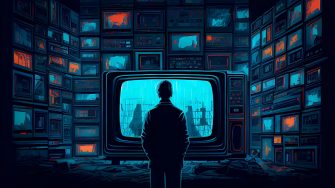
We are all surrounded by an abundance of information, from social media to newspaper articles and what is broadcast on television and radio. But what happens if that information is used to misinform or influence us? UNSW Canberra’s Dr Sally Burt tells us more about the underpinning threat of information warfare.
What does information warfare refer to?
The term information warfare covers a wide range of activities and concepts. Often the term is used to mean different things by different people and there is also a misconception that because we are living in the “information age” or an information society that these concepts and activities are new.
Information warfare can be defined as the use of activities and operations to manipulate information for the purposes of influencing political systems and decision-making.
It relates to political warfare, influence operations and other “grey zone” activities states engage in. These are measures, short of war, used to influence another state to achieve one’s own national interests. In this sense it is as old as warfare and diplomacy – it just happens in a much more visible way and on a much broader scale in this new information age, which provides an information environment that is easily penetrated and through which messages are easily dispersed.
With a continual, endless wave of information reaching billions of people every day the ability to quickly and easily distinguish between fact and fiction is diminished, and this plays into the hands of those who want to spread misinformation, seek to influence or incite particular responses.
Why should the everyday person care about information warfare?
Everybody should understand and be concerned about information warfare because we all operate in the information environment. As soon as we turn on (or activate our already on) devices that are connected to the internet or hook into Wi-Fi, we are operating in a space that has the potential to impact Australia’s national security. That’s a big responsibility and one most people take far too lightly at present. All of these devices collect data from us and have the potential to be accessed by a range of actors if they are intent on doing so. Those actors could be criminals trying to feed their bank account, nuisance hackers simply feeding their ego, through to adversarial state actors collecting data and information that can be used to influence or blackmail the general population or politicians, public servants or to cause disruption through infrastructure interference or to undermine democratic systems for their own gain.
Each of us, then, needs to play a role in Australia’s national security by understanding the potential dangers in our everyday activities and know how to protect ourselves and society while we engage in them.
What examples of information warfare have impacted Australia?
Australia’s Parliament and senior officials have been targeted by cyber-attacks on several occasions over recent years. China’s attempts to influence public officials have been very publicly noted. China’s trade sanctions and barriers imposed in response to the Australian government’s request for an investigation into the origins of COVID-19 were an attempt to coerce policy-makers and drive the narrative around the pandemic.
There are also less visible activities such as the stirring of divisions within society to assist with the narrative undermining democracy, such as instigating protests and inciting violence at them to draw attention to and amplify disagreement between different groups within our society. This allows authoritarian states to present a narrative around how dysfunctional democracies are and when heavy handed tactics are used to bring unrest under control, this can be used to excuse their use of these tactics.
How can Australia protect the nation from information warfare?
Awareness is the biggest key to protecting the nation from the effects of information warfare. A robust democracy, democratic institutions and a resilient population don’t hurt either. It requires a whole-of-state approach. We need the authorities and government agencies to be at the forefront of new technology and anticipating where the next threat is coming from and in which form so they can protect the general population from it. There is also a role for each of us to ensure we understand how to protect ourselves while using connected devices in the technical sense, but also while reading a newspaper, using Facebook, looking at TikTok videos in terms of asking questions and thinking critically about when we are trying to be influenced or manipulated.
The key is to find ways to protect information, state institutions and democratic functions in ways that don’t undermine our practice of democratic values but enhance them.
We can’t end democracy to protect it. We need to empower people. We need to understand vulnerabilities created by our connected society and find ways to avoid those vulnerabilities being exploited so that we can enjoy the plethora of benefits found in that connectivity.

